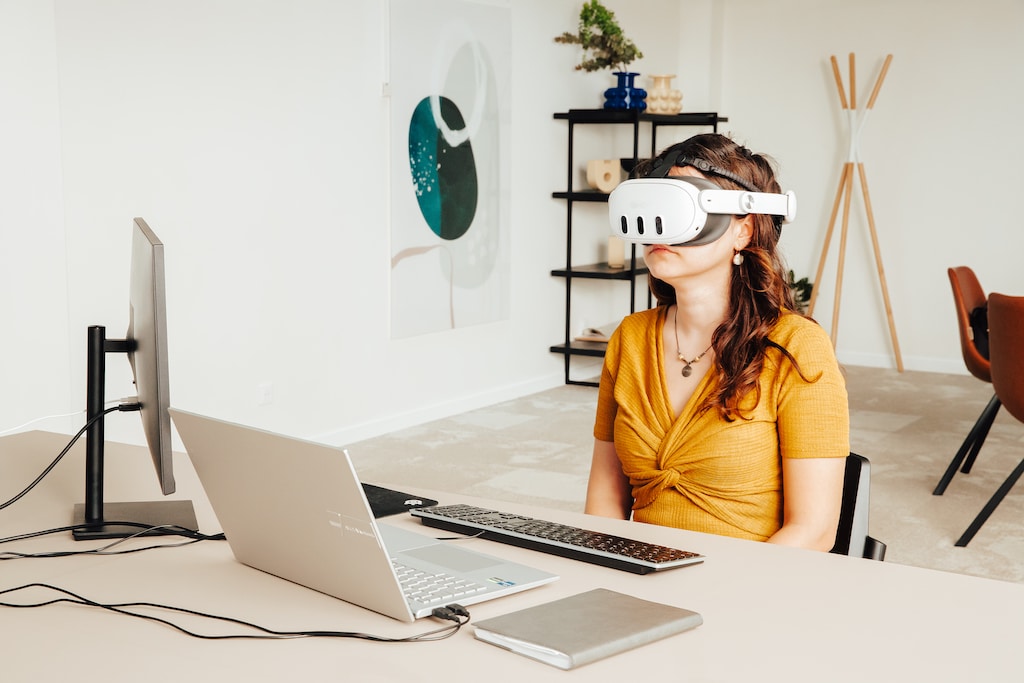Electroencephalography, or EEG, is a powerful non-invasive technique that captures the electrical activity of the brain. Over the decades, EEG has evolved from a novel experimental method into an indispensable tool in both clinical and research settings. By recording the brain’s electrical impulses through electrodes placed on the scalp, EEG provides real-time insights into neural dynamics that underpin everything from basic sensory processing to complex cognitive functions. How does it work exactly? That’s what this article uncovers.
Decoding brain waves: Understanding EEG
EEG stands for electroencephalography, which refers to the process of recording the brain’s electrical signals. Brains cells called neurons communicate through electrical impulses. When many neurons activate or fire synchronously, they generate waves that can be detected on the scalp.
An EEG cap contains sensors known as EEG electrodes to perceive the voltage shift with high temporal resolution. The resulting data appear as waveforms that represent the brain’s overall electrical activity. Brain wave patterns are classically divided into delta (0.5-4 Hz), alpha (8-12 Hz), beta (12-35 Hz), theta (4-8 Hz) and gamma (32-100 Hz) waves.
The origins of EEG date back to the early 20th century when scientists first discovered that brain activity could be visualised in the form of oscillatory patterns. Over the years, technological improvements have refined the accuracy and resolution of EEG recordings. Today, the technique is widely used to explore various states of consciousness, from the deep sleep of a calm night to the heightened alertness required during problem-solving.
EEG is highly valued because of its excellent temporal resolution. Unlike imaging techniques such as fMRI, which reveal the precise location of brain activity sources, EEG captures rapid fluctuations in neural activity perceived from different sources simultaneously, offering a near-instantaneous view of the brain in action. This capability is particularly important when studying events that unfold over milliseconds, such as sensory processing and motor responses.

EEG (electroencephalogram).
Inside the process: How EEG captures your brain's symphony
The term EEG covers a wide spectrum of products and procedures, all of which rely on attaching electrodes to your scalp to capture the brain’s electrical activity. However, the devices can differ significantly in their technical characteristics, particularly regarding the number and type of electrodes used.
In research and clinical settings, systems may incorporate up to 256 electrodes for detailed mapping, while consumer devices often rely on just a few sensors placed at strategic brain regions. The entire EEG procedure is non-invasive and painless, making it suitable for individuals of all ages.
A critical factor in EEG technology is the choice of electrodes, which generally falls into three categories:
– dry;
– gel-based (wet);
– saline electrodes.
Dry electrodes operate without any conductive medium but may compromise signal quality and comfort, although easy and fast to set up. Gel-based electrodes require a conductive gel to ensure optimal contact, offering excellent signal fidelity but necessitating a longer setup time and subsequent cleaning. Saline electrodes use sponges soaked in saline solution as the conductive medium, striking an ideal balance between ease of use, comfort, and signal quality.
During the recording session, patients are typically asked to remain as still as possible. Movement, blinking, and muscle contractions can introduce artifacts—extraneous signals that may obscure the brain’s genuine electrical patterns. Although existing denoising algorithms help to clean most of those artifacts either in real time or after recording.
In some protocols, subjects may be asked to perform specific tasks or respond to external stimuli, such as flashing lights or auditory cues. These tasks are designed to evoke particular brain responses, allowing researchers to study how the brain processes sensory information and responds to environmental changes.
High-quality wearables monitoring nervous system activity.
From diagnosis to innovation: The many faces of EEG
EEG’s versatility has led to its widespread adoption across multiple domains. Its applications range from clinical diagnosis and treatment monitoring to advanced research in cognitive neuroscience and the development of innovative brain-computer interfaces.
Clinical diagnosis and monitoring
One of the most well-known applications of EEG is in the diagnosis of epilepsy. Epileptic seizures are characterised by abnormal, excessive neuronal activity. As we have seen, EEG is uniquely suited to detect these irregular patterns. By identifying specific waveforms associated with seizure activity, clinicians can diagnose epilepsy with a high degree of confidence [1][2].
EEG is also used to evaluate sleep disorders such as narcolepsy and sleep apnea by monitoring brain activity during different sleep stages [3].
In addition to epilepsy and sleep disorders, EEG plays a critical role in assessing brain function following head injuries or strokes. The technique can reveal disruptions in normal electrical patterns, helping clinicians determine the extent of brain damage and monitor recovery over time. Furthermore, EEG is sometimes employed to evaluate brain death, providing an objective measure of the cessation of electrical activity in the brain.
Cognitive and neuroscientific research
Beyond its clinical applications, EEG is a cornerstone in cognitive neuroscience research. Its high temporal resolution allows scientists to track the sequence of neural events as the brain processes stimuli, making it ideal for studying sensory perception, attention, memory, and decision-making.
Researchers employ event-related potentials (ERPs), which are averaged EEG responses time-locked to specific events, to investigate how the brain responds to different types of sensory input or cognitive challenges [4].
For example, in studies of visual perception, researchers might present a series of images and use EEG to determine how quickly and efficiently the brain distinguishes between different visual stimuli. Similarly, in studies of language processing, EEG helps researchers understand the rapid brain responses that occur when an individual hears or reads words.
These insights contribute significantly to our understanding of the underlying neural mechanisms that support cognition and behavior.
Brain-computer interfaces (BCIs)
One of the most exciting applications of EEG relies in the field of brain-computer interfaces. BCIs translate brain signals into commands that can control external devices, offering new avenues for communication and interaction, especially for individuals with severe motor disabilities.
For instance, EEG-based BCIs can enable paralysed patients to operate computers, prosthetic limbs, or wheelchairs using only their brain activity. This technology not only enhances independence, it also dramatically improves the quality of life for those affected by conditions such as amyotrophic lateral sclerosis (ALS) or spinal cord injuries.
In addition to medical applications, EEG is increasingly being used in consumer technology [5]. Neurofeedback training, which allows individuals to learn how to modulate their own brain activity, has been applied to improve focus, reduce anxiety, and even optimise performance in sports and academics. Furthermore, immersive virtual reality (VR) and gaming platforms are beginning to integrate EEG data to adapt game dynamics in real time, creating more engaging and personalised experiences [6].

Overcoming boundaries: EEG today and tomorrow
One of the most exciting applications of EEG relies in the field of brain-computer interfaces. BCIs translate brain signals into commands that can control external devices, offering new avenues for communication and interaction, especially for individuals with severe motor disabilities.
For instance, EEG-based BCIs can enable paralysed patients to operate computers, prosthetic limbs, or wheelchairs using only their brain activity. This technology not only enhances independence, it also dramatically improves the quality of life for those affected by conditions such as amyotrophic lateral sclerosis (ALS) or spinal cord injuries [7].
In addition to medical applications, EEG is increasingly being used in consumer technology. Neurofeedback training, which allows individuals to learn how to modulate their own brain activity, has been applied to improve focus, reduce anxiety, and even optimise performance in sports and academics. Furthermore, immersive virtual reality (VR) and gaming platforms are beginning to integrate EEG data to adapt game dynamics in real time, creating more engaging and personalised experiences [6].

Portable EEG combined with VR headset.
Neuromind: Portable EEG combined with VR headset
Neuromind is an innovative, user-friendly EEG device that integrates seamlessly with a VR headset, ensuring that high-quality neural data are captured without compromising on user comfort. Thanks to the proprietary biomarkers of attention and emotion, Neuromind is able to measure the states of vigilance and emotional reactivity thereby enabling neurocognitive modulation.
The design and component selection for Neuromind were guided by several key criteria:
– VR compatibility: the system is engineered to integrate easily with VR headsets, guaranteeing that the additional hardware does not interfere with signal acquisition or user comfort.
– Ease of installation: with a setup time of less than 5 minutes, Neuromind is designed for quick and hassle-free installation.
– Choice of electrodes: neuromind employs saline electrodes, which offer an optimal balance between dry and gel electrodes, combining the easy setup of the former with a signal quality closer to the latter.
-Electrode placement: special attention is given to electrode positioning, particularly over central and occipital areas, to effectively capture the brain activity most relevant to attentional and emotional processing.
– Affordability: the device is designed to remain cost-effective, broadening its accessibility to a wider audience [8].
– Access to the raw data of the recorded signal.
By combining these carefully considered features, Neuromind exemplifies how EEG technology can be a groundbreaking advancement in neuroscience.
In essence, EEG is much more than a diagnostic instrument; it is a versatile bridge between our understanding of neural function and the practical applications that arise from this knowledge. Whether in the clinic, the laboratory, or even in everyday consumer technology, EEG continues to inspire innovation and deepen our grasp of the human mind. If you’d like to find out more about our Neuromind device, we’d be delighted to arrange a presentation.
[1] Smith SJM. EEG in the diagnosis, classification, and management of patients with epilepsy. Journal of Neurology, Neurosurgery & Psychiatry 2005;76:ii2-ii7.
[2] Smith, S. J. M. (2005). EEG in the diagnosis, classification, and management of patients with epilepsy. Journal of Neurology, Neurosurgery & Psychiatry, 76(suppl 2), ii2-ii7.
[3] Campbell, I. G. (2009). EEG recording and analysis for sleep research. Current protocols in neuroscience, 49(1), 10-2.
[4] Abhang, P. A., Gawali, B. W., & Mehrotra, S. C. (2016). Technological basics of EEG recording and operation of apparatus. In: Introduction to EEG-and speech-based emotion recognition. Academic Press. Pgs 19-50.
[5] Amin, C. R., Hasin, M. F., Leon, T. S., Aurko, A. B., Tamanna, T., Rahman, M. A., & Parvez, M. Z. (2020, December). Consumer Behavior Analysis using EEG Signals for Neuromarketing Application. In 2020 IEEE Symposium Series on Computational Intelligence (SSCI) (pp. 2061-2066). IEEE.
[6] Vasiljevic, Gabriel Alves Mendes, and Leonardo Cunha de Miranda. Brain–computer interface games based on consumer-grade EEG Devices: A systematic literature review. International Journal of Human–Computer Interaction 36, no. 2 (2020): 105-142.
[7] Liao, L. D., Lin, C. T., McDowell, K., Wickenden, A. E., Gramann, K., Jung, T. P., … & Chang, J. Y. (2012). Biosensor technologies for augmented brain–computer interfaces in the next decades. Proceedings of the IEEE, 100(Special Centennial Issue), 1553-1566.
[8] Pathirana, S., Asirvatham, D., & Johar, G. (2018, July). A critical evaluation on low-cost consumer-grade electroencephalographic devices. In 2018 2nd International Conference on BioSignal Analysis, Processing and Systems (ICBAPS) (pp. 160-165). IEEE.
